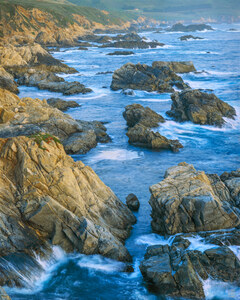
Otter Cove, Big Sur, California
Last light—on one of the northernmost stretches of the Big Sur coast, not far south of Point Lobos. By the time I was ready and the waves were sufficient, the light appeared to have faded, but the film said otherwise. The exposure had to be made nearly wide-open, at f/11, to avoid excessive water movement. Transparency films are far less tolerant of exposure variation than either black and white or color negative films. The latitude of transparency films is often less than zero, that is, most subjects would be both over and underexposed at the same time with an averaging exposure. For this and other reasons, obtaining optimum exposures with transparencies is far more difficult than with negatives. To understand film well, it was absolutely essential to know very well the nature and meaning of the film's so-called characteristic curve or density vs. log exposure curve (or three curves in the case of color film). This is the logarithmically plotted graph of the optical density which results in a film, with given processing, in response to a full range of exposure levels. Today's sensors have changed this situation rather drastically, affording ready access to a much longer tone scale, easy control over exposure levels, tremendously more sensitivity to light, and the chance for perfect white balance after the fact.

